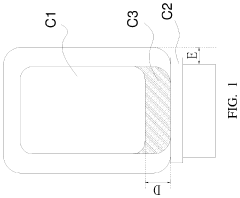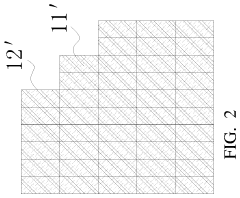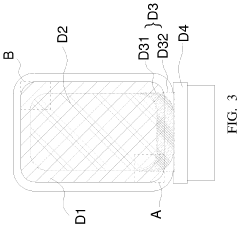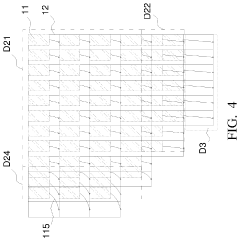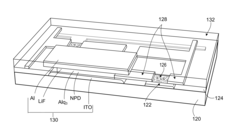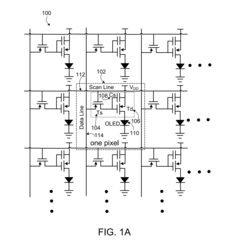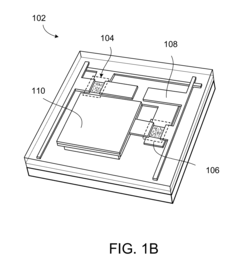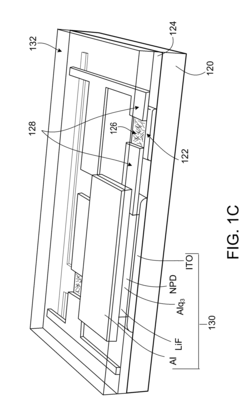AMOLED advancements in autonomous vehicle interfaces.
JUL 17, 20259 MIN READ
Generate Your Research Report Instantly with AI Agent
Patsnap Eureka helps you evaluate technical feasibility & market potential.
AMOLED Evolution in Automotive HMI
The evolution of AMOLED technology in automotive Human-Machine Interfaces (HMI) has been marked by significant advancements over the past decade. Initially introduced in high-end luxury vehicles, AMOLED displays have gradually become more prevalent across various vehicle segments, driven by the increasing demand for sophisticated and visually appealing in-car interfaces.
The automotive industry's shift towards electrification and autonomous driving has accelerated the adoption of AMOLED technology. As vehicles become more software-defined, the need for high-quality, flexible displays has grown exponentially. AMOLED screens offer superior contrast ratios, wider color gamuts, and faster response times compared to traditional LCD displays, making them ideal for conveying critical information in autonomous vehicles.
One of the key milestones in AMOLED's automotive journey was the development of flexible and curved displays. This innovation allowed designers to integrate screens seamlessly into the vehicle's interior, creating more immersive and ergonomic cockpit designs. The ability to conform to non-flat surfaces has opened up new possibilities for integrating displays into areas previously considered impractical.
Another significant advancement has been the improvement in AMOLED's durability and longevity. Early iterations faced challenges related to burn-in and degradation over time, especially in the harsh automotive environment. However, manufacturers have made substantial progress in mitigating these issues through the use of advanced materials and compensation algorithms.
The introduction of transparent AMOLED displays marks a revolutionary step in automotive HMI. These displays can be integrated into windshields and side windows, enabling augmented reality (AR) applications that overlay navigation information, safety alerts, and other relevant data directly onto the driver's view of the road. This technology is particularly crucial for enhancing situational awareness in autonomous vehicles.
Energy efficiency has been another focus area in AMOLED evolution. As electric vehicles become more prevalent, the power consumption of in-car displays has become a critical consideration. AMOLED technology has made significant strides in this regard, with newer generations consuming less power while delivering brighter and more vivid images.
The most recent developments in AMOLED for automotive applications include the integration of haptic feedback and the use of quantum dot technology to enhance color accuracy and brightness. These advancements are paving the way for more interactive and responsive interfaces, crucial for the transition to fully autonomous vehicles where the line between entertainment and information display becomes increasingly blurred.
The automotive industry's shift towards electrification and autonomous driving has accelerated the adoption of AMOLED technology. As vehicles become more software-defined, the need for high-quality, flexible displays has grown exponentially. AMOLED screens offer superior contrast ratios, wider color gamuts, and faster response times compared to traditional LCD displays, making them ideal for conveying critical information in autonomous vehicles.
One of the key milestones in AMOLED's automotive journey was the development of flexible and curved displays. This innovation allowed designers to integrate screens seamlessly into the vehicle's interior, creating more immersive and ergonomic cockpit designs. The ability to conform to non-flat surfaces has opened up new possibilities for integrating displays into areas previously considered impractical.
Another significant advancement has been the improvement in AMOLED's durability and longevity. Early iterations faced challenges related to burn-in and degradation over time, especially in the harsh automotive environment. However, manufacturers have made substantial progress in mitigating these issues through the use of advanced materials and compensation algorithms.
The introduction of transparent AMOLED displays marks a revolutionary step in automotive HMI. These displays can be integrated into windshields and side windows, enabling augmented reality (AR) applications that overlay navigation information, safety alerts, and other relevant data directly onto the driver's view of the road. This technology is particularly crucial for enhancing situational awareness in autonomous vehicles.
Energy efficiency has been another focus area in AMOLED evolution. As electric vehicles become more prevalent, the power consumption of in-car displays has become a critical consideration. AMOLED technology has made significant strides in this regard, with newer generations consuming less power while delivering brighter and more vivid images.
The most recent developments in AMOLED for automotive applications include the integration of haptic feedback and the use of quantum dot technology to enhance color accuracy and brightness. These advancements are paving the way for more interactive and responsive interfaces, crucial for the transition to fully autonomous vehicles where the line between entertainment and information display becomes increasingly blurred.
Market Demand for Advanced Vehicle Displays
The demand for advanced vehicle displays, particularly AMOLED technology in autonomous vehicle interfaces, has been steadily increasing in recent years. This growth is driven by the automotive industry's shift towards more sophisticated and user-friendly in-vehicle experiences. As autonomous vehicles become more prevalent, the need for high-quality, responsive, and versatile displays has become paramount.
AMOLED displays offer several advantages that make them particularly attractive for autonomous vehicle interfaces. Their superior contrast ratios, wider color gamut, and faster response times contribute to enhanced visibility and readability, crucial factors in ensuring driver and passenger safety. The ability of AMOLED displays to produce true blacks and vibrant colors also allows for more intuitive and visually appealing user interfaces, which can significantly improve the overall user experience in autonomous vehicles.
Market research indicates that the global automotive display market is expected to grow substantially in the coming years, with AMOLED technology playing a significant role in this expansion. The increasing integration of advanced driver assistance systems (ADAS) and infotainment features in vehicles is a key driver of this market growth. Autonomous vehicles, in particular, require larger and more sophisticated display systems to convey complex information about the vehicle's surroundings, navigation, and system status.
Consumer preferences are also shaping the demand for AMOLED displays in vehicles. As users become accustomed to high-quality displays in their smartphones and other personal devices, they increasingly expect similar visual experiences in their vehicles. This trend is particularly pronounced in the luxury and premium vehicle segments, where advanced display technologies are often seen as a differentiating factor.
The automotive industry's focus on reducing energy consumption aligns well with AMOLED technology. These displays are more energy-efficient compared to traditional LCD screens, especially when displaying darker content, which is common in automotive applications. This energy efficiency can contribute to extended battery life in electric and autonomous vehicles, addressing range anxiety concerns.
As autonomous driving technology advances, the role of in-vehicle displays is evolving from mere information presentation to becoming a central hub for interaction and entertainment. This shift is creating new opportunities for AMOLED displays, such as curved or flexible screens that can be seamlessly integrated into vehicle interiors. The potential for transparent AMOLED displays in windshields and windows is also being explored, offering new possibilities for augmented reality applications in autonomous vehicles.
AMOLED displays offer several advantages that make them particularly attractive for autonomous vehicle interfaces. Their superior contrast ratios, wider color gamut, and faster response times contribute to enhanced visibility and readability, crucial factors in ensuring driver and passenger safety. The ability of AMOLED displays to produce true blacks and vibrant colors also allows for more intuitive and visually appealing user interfaces, which can significantly improve the overall user experience in autonomous vehicles.
Market research indicates that the global automotive display market is expected to grow substantially in the coming years, with AMOLED technology playing a significant role in this expansion. The increasing integration of advanced driver assistance systems (ADAS) and infotainment features in vehicles is a key driver of this market growth. Autonomous vehicles, in particular, require larger and more sophisticated display systems to convey complex information about the vehicle's surroundings, navigation, and system status.
Consumer preferences are also shaping the demand for AMOLED displays in vehicles. As users become accustomed to high-quality displays in their smartphones and other personal devices, they increasingly expect similar visual experiences in their vehicles. This trend is particularly pronounced in the luxury and premium vehicle segments, where advanced display technologies are often seen as a differentiating factor.
The automotive industry's focus on reducing energy consumption aligns well with AMOLED technology. These displays are more energy-efficient compared to traditional LCD screens, especially when displaying darker content, which is common in automotive applications. This energy efficiency can contribute to extended battery life in electric and autonomous vehicles, addressing range anxiety concerns.
As autonomous driving technology advances, the role of in-vehicle displays is evolving from mere information presentation to becoming a central hub for interaction and entertainment. This shift is creating new opportunities for AMOLED displays, such as curved or flexible screens that can be seamlessly integrated into vehicle interiors. The potential for transparent AMOLED displays in windshields and windows is also being explored, offering new possibilities for augmented reality applications in autonomous vehicles.
AMOLED Challenges in Automotive Environment
AMOLED displays face significant challenges when integrated into automotive environments, particularly for autonomous vehicle interfaces. The harsh conditions within vehicles, including extreme temperatures, vibrations, and varying light conditions, pose unique obstacles for these advanced displays.
Temperature fluctuations are a primary concern, as vehicles can experience a wide range of temperatures depending on climate and parking conditions. AMOLED displays are sensitive to both high and low temperatures, which can affect their performance and longevity. Extreme heat can lead to accelerated degradation of organic materials, while cold temperatures may cause temporary display issues or slow response times.
Vibration and shock resistance are critical factors in automotive applications. The constant vibrations from road conditions and engine operation can potentially damage the delicate AMOLED panels or their connections, leading to display failures or reduced lifespan. Ensuring robust mounting and cushioning systems is essential to mitigate these effects.
Sunlight readability presents another significant challenge for AMOLED displays in vehicles. The high ambient light conditions often encountered while driving can wash out display content, reducing visibility and compromising the user interface's effectiveness. This issue is particularly critical for autonomous vehicle interfaces, where clear and immediate information display is crucial for safety and user confidence.
Power consumption and heat generation are additional concerns in automotive environments. AMOLED displays, while generally energy-efficient, can still contribute to the overall power draw and heat load within a vehicle's electrical system. Balancing display performance with energy efficiency is crucial, especially in electric and autonomous vehicles where power management is paramount.
Durability and lifespan considerations are heightened in automotive applications. AMOLED displays must withstand years of continuous operation in challenging conditions, maintaining consistent performance and image quality throughout the vehicle's lifetime. This requires addressing issues such as pixel degradation, color shift, and burn-in, which can be exacerbated by the automotive environment.
EMI (Electromagnetic Interference) and EMC (Electromagnetic Compatibility) present unique challenges in vehicle integration. AMOLED displays must not only resist interference from other vehicle systems but also avoid generating electromagnetic emissions that could affect sensitive automotive electronics.
Finally, the automotive industry's stringent safety and reliability standards pose additional hurdles for AMOLED integration. Displays must meet specific certifications and performance criteria, ensuring they remain functional and safe under all operating conditions, including potential crash scenarios.
Temperature fluctuations are a primary concern, as vehicles can experience a wide range of temperatures depending on climate and parking conditions. AMOLED displays are sensitive to both high and low temperatures, which can affect their performance and longevity. Extreme heat can lead to accelerated degradation of organic materials, while cold temperatures may cause temporary display issues or slow response times.
Vibration and shock resistance are critical factors in automotive applications. The constant vibrations from road conditions and engine operation can potentially damage the delicate AMOLED panels or their connections, leading to display failures or reduced lifespan. Ensuring robust mounting and cushioning systems is essential to mitigate these effects.
Sunlight readability presents another significant challenge for AMOLED displays in vehicles. The high ambient light conditions often encountered while driving can wash out display content, reducing visibility and compromising the user interface's effectiveness. This issue is particularly critical for autonomous vehicle interfaces, where clear and immediate information display is crucial for safety and user confidence.
Power consumption and heat generation are additional concerns in automotive environments. AMOLED displays, while generally energy-efficient, can still contribute to the overall power draw and heat load within a vehicle's electrical system. Balancing display performance with energy efficiency is crucial, especially in electric and autonomous vehicles where power management is paramount.
Durability and lifespan considerations are heightened in automotive applications. AMOLED displays must withstand years of continuous operation in challenging conditions, maintaining consistent performance and image quality throughout the vehicle's lifetime. This requires addressing issues such as pixel degradation, color shift, and burn-in, which can be exacerbated by the automotive environment.
EMI (Electromagnetic Interference) and EMC (Electromagnetic Compatibility) present unique challenges in vehicle integration. AMOLED displays must not only resist interference from other vehicle systems but also avoid generating electromagnetic emissions that could affect sensitive automotive electronics.
Finally, the automotive industry's stringent safety and reliability standards pose additional hurdles for AMOLED integration. Displays must meet specific certifications and performance criteria, ensuring they remain functional and safe under all operating conditions, including potential crash scenarios.
Current AMOLED Solutions for Vehicle Interfaces
01 AMOLED display driving techniques
Various driving techniques are employed in AMOLED displays to improve performance and efficiency. These include methods for controlling pixel brightness, reducing power consumption, and enhancing image quality. Advanced driving schemes can compensate for variations in OLED characteristics and optimize display output.- AMOLED display driving techniques: Various driving techniques are employed in AMOLED displays to improve performance and efficiency. These may include methods for controlling pixel brightness, reducing power consumption, and enhancing image quality. Advanced driving schemes can help address issues such as non-uniformity and degradation in OLED displays.
- AMOLED display structure and fabrication: The structure and fabrication processes of AMOLED displays are crucial for their performance. This includes the design of pixel circuits, thin-film transistors, and light-emitting layers. Innovations in display structure can lead to improved efficiency, higher resolution, and better color reproduction.
- Touch and display integration in AMOLED: Integration of touch functionality with AMOLED displays is a key area of development. This involves designing interfaces that combine touch sensing and display driving, potentially reducing complexity and improving overall device performance. Such integration can lead to thinner and more responsive devices.
- Power management in AMOLED displays: Efficient power management is crucial for AMOLED displays, especially in mobile devices. This includes techniques for reducing power consumption, optimizing brightness control, and implementing power-saving modes. Advanced power management can significantly extend battery life in AMOLED-equipped devices.
- Image quality enhancement for AMOLED: Various techniques are employed to enhance image quality in AMOLED displays. These may include methods for improving color accuracy, contrast, and brightness uniformity. Advanced algorithms and hardware solutions can help address issues such as image retention and color shift, resulting in superior visual performance.
02 AMOLED pixel structure and layout
The design of AMOLED pixel structures and layouts plays a crucial role in display performance. This includes innovations in sub-pixel arrangements, transistor configurations, and light-emitting area optimization. These advancements aim to improve resolution, color accuracy, and overall display efficiency.Expand Specific Solutions03 Touch integration in AMOLED displays
Integrating touch functionality into AMOLED displays is a key area of development. This involves creating interfaces that combine touch sensors with display elements, enabling responsive and accurate touch input while maintaining display quality. Various approaches are used to achieve seamless touch integration without compromising display performance.Expand Specific Solutions04 AMOLED display power management
Power management is crucial for AMOLED displays, especially in mobile devices. Techniques are developed to reduce power consumption while maintaining display quality. This includes adaptive brightness control, selective pixel activation, and efficient driving methods that optimize power usage across different display content and conditions.Expand Specific Solutions05 AMOLED display compensation and calibration
Compensation and calibration techniques are essential for maintaining consistent performance in AMOLED displays. These methods address issues such as pixel aging, color shift, and brightness variations. Advanced algorithms and sensing technologies are employed to detect and correct display irregularities, ensuring long-term stability and image quality.Expand Specific Solutions
Key AMOLED Suppliers for Automotive Sector
The AMOLED advancements in autonomous vehicle interfaces market is in a growth phase, driven by increasing adoption of autonomous vehicles and demand for high-quality displays. The market size is expanding rapidly, with major players like BOE Technology, TCL China Star, and Innolux Corp leading the way. These companies are investing heavily in R&D to improve AMOLED technology for automotive applications. The technology is maturing, with advancements in display quality, durability, and integration with vehicle systems. However, challenges remain in areas such as cost reduction and mass production for automotive-grade displays. Collaboration between display manufacturers and automotive companies like NIO, GM, and Zenseact is accelerating innovation and market adoption.
BOE Technology Group Co., Ltd.
Technical Solution: BOE has developed advanced AMOLED displays specifically tailored for autonomous vehicle interfaces. Their technology incorporates high refresh rates of up to 120Hz, enhancing the smoothness of displayed information[1]. The displays feature a wide color gamut covering 100% of the DCI-P3 color space, ensuring vibrant and accurate color reproduction[2]. BOE's AMOLED panels for automotive use also boast high brightness levels, reaching up to 1000 nits, which significantly improves visibility in various lighting conditions, including direct sunlight[3]. Additionally, they have implemented low-temperature polysilicon (LTPS) backplane technology, which allows for higher pixel density and improved power efficiency compared to traditional a-Si TFT displays[4].
Strengths: High refresh rates, wide color gamut, and high brightness levels enhance user experience and readability. LTPS technology improves efficiency and display quality. Weaknesses: Potentially higher production costs compared to traditional LCD displays, which may impact overall vehicle pricing.
TCL China Star Optoelectronics Technology Co., Ltd.
Technical Solution: TCL CSOT has developed AMOLED displays for autonomous vehicle interfaces with a focus on durability and reliability. Their panels utilize advanced encapsulation techniques to protect against moisture and oxygen, extending the lifespan of the displays in harsh automotive environments[5]. The company has also implemented a unique pixel compensation algorithm to mitigate burn-in effects, a common issue with OLED displays[6]. TCL CSOT's AMOLED panels for automotive use feature low power consumption, with an average reduction of 30% compared to equivalent LCD displays[7]. Furthermore, they have developed flexible AMOLED panels that can be curved or bent to fit various interior designs, offering greater design freedom for vehicle manufacturers[8].
Strengths: Enhanced durability, burn-in mitigation, and power efficiency make these displays well-suited for long-term use in vehicles. Flexible panels offer design versatility. Weaknesses: The advanced technologies used may result in higher initial costs for vehicle manufacturers.
Innovations in Automotive-Grade AMOLED
Active matrix organic light-emitting diode display panel
PatentInactiveUS20200185467A1
Innovation
- The AMOLED display panel design includes a driving circuit region with a smaller area than the display light-emitting region, where the display light-emitting region completely covers the driving circuit and fan-out regions, with optimized placement of driving units and display units to reduce the area of the lower edge region and fan-out trace, allowing for a narrower frame.
Separated Carbon Nanotube-Based Active Matrix Organic Light-Emitting Diode Displays
PatentInactiveUS20140070169A1
Innovation
- The use of separated semiconducting nanotubes as the active channel material in transistors, with a network of nanotubes disposed over a functionalized gate dielectric layer, and integrated into a display control circuit to drive OLED pixels, enabling high on/off ratios and current density.
Safety Standards for Automotive Displays
Safety standards for automotive displays in autonomous vehicles have become increasingly critical as AMOLED technology advances in vehicle interfaces. These standards are designed to ensure that displays not only provide clear and accurate information but also minimize driver distraction and maintain visibility under various lighting conditions.
The National Highway Traffic Safety Administration (NHTSA) in the United States has established guidelines for in-vehicle electronic devices, including display systems. These guidelines emphasize the importance of limiting visual-manual distraction and ensuring that displays do not interfere with the driver's primary task of operating the vehicle safely. For AMOLED displays in autonomous vehicles, this translates to requirements for high contrast ratios, wide viewing angles, and rapid response times to prevent image lag or ghosting.
In Europe, the United Nations Economic Commission for Europe (UNECE) has developed regulations specifically addressing the safety of electronic display systems in vehicles. Regulation No. 21, for instance, covers the interior fittings of motor vehicles and includes provisions for display placement and visibility. AMOLED displays must comply with these regulations, demonstrating their ability to maintain readability under various ambient light conditions and withstand the rigors of automotive environments.
The International Organization for Standardization (ISO) has also contributed to the development of safety standards for automotive displays. ISO 15008 specifies the requirements for the visual presentation of information in road vehicles, including legibility, color discrimination, and symbol recognition. AMOLED displays in autonomous vehicles must meet or exceed these standards to ensure that critical information is conveyed effectively to both human drivers and autonomous systems.
As autonomous vehicles become more prevalent, new safety standards are emerging to address the unique challenges of human-machine interfaces in these vehicles. The Society of Automotive Engineers (SAE) has developed guidelines for automated driving systems, including recommendations for display systems that communicate the vehicle's status and intentions to passengers and other road users. AMOLED displays play a crucial role in implementing these communication systems, requiring adherence to strict safety and performance standards.
Manufacturers of AMOLED displays for autonomous vehicle interfaces must also consider electromagnetic compatibility (EMC) standards to ensure that the displays do not interfere with other electronic systems in the vehicle. Standards such as CISPR 25 and ISO 11452 set limits for electromagnetic emissions and immunity, respectively, which AMOLED displays must meet to be considered safe for automotive use.
As AMOLED technology continues to advance, safety standards for automotive displays are likely to evolve, incorporating new requirements for features such as haptic feedback, gesture recognition, and augmented reality overlays. These standards will need to balance the potential benefits of advanced display technologies with the paramount concern for vehicle and passenger safety in the autonomous driving era.
The National Highway Traffic Safety Administration (NHTSA) in the United States has established guidelines for in-vehicle electronic devices, including display systems. These guidelines emphasize the importance of limiting visual-manual distraction and ensuring that displays do not interfere with the driver's primary task of operating the vehicle safely. For AMOLED displays in autonomous vehicles, this translates to requirements for high contrast ratios, wide viewing angles, and rapid response times to prevent image lag or ghosting.
In Europe, the United Nations Economic Commission for Europe (UNECE) has developed regulations specifically addressing the safety of electronic display systems in vehicles. Regulation No. 21, for instance, covers the interior fittings of motor vehicles and includes provisions for display placement and visibility. AMOLED displays must comply with these regulations, demonstrating their ability to maintain readability under various ambient light conditions and withstand the rigors of automotive environments.
The International Organization for Standardization (ISO) has also contributed to the development of safety standards for automotive displays. ISO 15008 specifies the requirements for the visual presentation of information in road vehicles, including legibility, color discrimination, and symbol recognition. AMOLED displays in autonomous vehicles must meet or exceed these standards to ensure that critical information is conveyed effectively to both human drivers and autonomous systems.
As autonomous vehicles become more prevalent, new safety standards are emerging to address the unique challenges of human-machine interfaces in these vehicles. The Society of Automotive Engineers (SAE) has developed guidelines for automated driving systems, including recommendations for display systems that communicate the vehicle's status and intentions to passengers and other road users. AMOLED displays play a crucial role in implementing these communication systems, requiring adherence to strict safety and performance standards.
Manufacturers of AMOLED displays for autonomous vehicle interfaces must also consider electromagnetic compatibility (EMC) standards to ensure that the displays do not interfere with other electronic systems in the vehicle. Standards such as CISPR 25 and ISO 11452 set limits for electromagnetic emissions and immunity, respectively, which AMOLED displays must meet to be considered safe for automotive use.
As AMOLED technology continues to advance, safety standards for automotive displays are likely to evolve, incorporating new requirements for features such as haptic feedback, gesture recognition, and augmented reality overlays. These standards will need to balance the potential benefits of advanced display technologies with the paramount concern for vehicle and passenger safety in the autonomous driving era.
Energy Efficiency of AMOLED in Vehicles
AMOLED (Active-Matrix Organic Light-Emitting Diode) technology has emerged as a promising solution for enhancing energy efficiency in autonomous vehicle interfaces. The integration of AMOLED displays in vehicles offers significant advantages in terms of power consumption, particularly when compared to traditional LCD screens.
One of the key factors contributing to the energy efficiency of AMOLED displays is their ability to selectively illuminate individual pixels. Unlike LCDs, which require constant backlighting, AMOLED screens can turn off pixels completely when displaying black, resulting in substantial power savings. This feature is particularly beneficial in automotive applications, where dark or dimmed interfaces are often used during nighttime driving.
The self-emissive nature of AMOLED technology also eliminates the need for power-hungry backlighting systems, further reducing overall energy consumption. This characteristic is especially advantageous in autonomous vehicles, where the display interface may need to remain active for extended periods, even when the vehicle is stationary or in low-power mode.
Recent advancements in AMOLED manufacturing processes have led to improved efficiency in terms of power consumption per unit area. These improvements have been achieved through the development of more efficient organic materials and optimized pixel structures, resulting in displays that require less power to produce the same level of brightness as their predecessors.
In the context of autonomous vehicles, AMOLED displays can be strategically implemented to maximize energy efficiency. For instance, adaptive brightness control systems can be integrated to automatically adjust screen luminance based on ambient light conditions, ensuring optimal visibility while minimizing power consumption. Additionally, the use of dark-themed user interfaces can leverage the power-saving capabilities of AMOLED technology, further reducing energy usage.
The energy efficiency of AMOLED displays also contributes to the overall range and performance of electric autonomous vehicles. By reducing the power demand of the vehicle's interface systems, more energy can be allocated to critical functions such as propulsion and sensor operation, potentially extending the vehicle's operational range.
Furthermore, the thin and flexible nature of AMOLED panels allows for innovative design solutions that can improve aerodynamics and reduce overall vehicle weight, indirectly contributing to enhanced energy efficiency. This flexibility in form factor also enables the integration of curved or contoured displays, which can be optimally positioned to minimize power consumption while maximizing visibility and user experience.
As autonomous vehicle technology continues to evolve, the energy efficiency of AMOLED displays is expected to play an increasingly important role in the design and functionality of vehicle interfaces. Ongoing research and development efforts are focused on further improving the power efficiency of AMOLED technology, with potential breakthroughs in areas such as quantum dot-enhanced OLED (QD-OLED) displays promising even greater energy savings in future automotive applications.
One of the key factors contributing to the energy efficiency of AMOLED displays is their ability to selectively illuminate individual pixels. Unlike LCDs, which require constant backlighting, AMOLED screens can turn off pixels completely when displaying black, resulting in substantial power savings. This feature is particularly beneficial in automotive applications, where dark or dimmed interfaces are often used during nighttime driving.
The self-emissive nature of AMOLED technology also eliminates the need for power-hungry backlighting systems, further reducing overall energy consumption. This characteristic is especially advantageous in autonomous vehicles, where the display interface may need to remain active for extended periods, even when the vehicle is stationary or in low-power mode.
Recent advancements in AMOLED manufacturing processes have led to improved efficiency in terms of power consumption per unit area. These improvements have been achieved through the development of more efficient organic materials and optimized pixel structures, resulting in displays that require less power to produce the same level of brightness as their predecessors.
In the context of autonomous vehicles, AMOLED displays can be strategically implemented to maximize energy efficiency. For instance, adaptive brightness control systems can be integrated to automatically adjust screen luminance based on ambient light conditions, ensuring optimal visibility while minimizing power consumption. Additionally, the use of dark-themed user interfaces can leverage the power-saving capabilities of AMOLED technology, further reducing energy usage.
The energy efficiency of AMOLED displays also contributes to the overall range and performance of electric autonomous vehicles. By reducing the power demand of the vehicle's interface systems, more energy can be allocated to critical functions such as propulsion and sensor operation, potentially extending the vehicle's operational range.
Furthermore, the thin and flexible nature of AMOLED panels allows for innovative design solutions that can improve aerodynamics and reduce overall vehicle weight, indirectly contributing to enhanced energy efficiency. This flexibility in form factor also enables the integration of curved or contoured displays, which can be optimally positioned to minimize power consumption while maximizing visibility and user experience.
As autonomous vehicle technology continues to evolve, the energy efficiency of AMOLED displays is expected to play an increasingly important role in the design and functionality of vehicle interfaces. Ongoing research and development efforts are focused on further improving the power efficiency of AMOLED technology, with potential breakthroughs in areas such as quantum dot-enhanced OLED (QD-OLED) displays promising even greater energy savings in future automotive applications.
Unlock deeper insights with Patsnap Eureka Quick Research — get a full tech report to explore trends and direct your research. Try now!
Generate Your Research Report Instantly with AI Agent
Supercharge your innovation with Patsnap Eureka AI Agent Platform!
